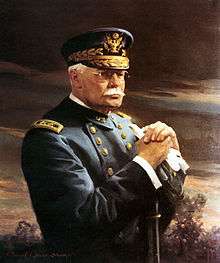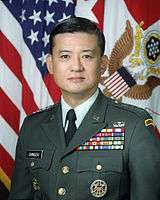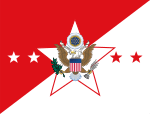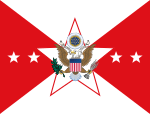Chief of Staff of the United States Army
| Chief of Staff of the United States Army
CSA | |
|---|---|
|
Flag of the Chief of Staff of the Army | |
|
Department of the Army The Army Staff | |
| Member of | Joint Chiefs of Staff |
| Reports to |
Secretary of Defense Secretary of the Army |
| Seat | The Pentagon, Arlington County, Virginia, U.S. |
| Appointer |
The President with Senate advice and consent |
| Term length |
4 years Renewable |
| Constituting instrument | 10 U.S.C. § 3033 |
| Precursor | Commanding General of the Army |
| Formation | August 15, 1903 |
| First holder | LTG Samuel B. M. Young |
| Deputy | Vice Chief of Staff of the Army |
| Website | Official Website |
The Chief of Staff of the Army (CSA) is a statutory office (10 U.S.C. § 3033) held by a four-star general in the United States Army. As the most senior uniformed officer assigned to serve in the Department of the Army, the CSA is the principal military advisor and a deputy to the Secretary of the Army. In a separate capacity, the CSA is a member of the Joint Chiefs of Staff (10 U.S.C. § 151) and, thereby, a military advisor to the National Security Council, the Secretary of Defense, and the President of the United States. The CSA is typically the highest-ranking officer on active-duty in the U.S. Army unless the Chairman and/or the Vice Chairman of the Joint Chiefs of Staff are Army officers.
The Chief of Staff of the Army is an administrative position based in the Pentagon. While the CSA does not have operational command authority over Army forces proper (which is within the purview of the Combatant Commanders who report to the Secretary of Defense), the CSA does exercise supervision of army units and organizations as the designee of the Secretary of the Army.
The current Chief of Staff of the Army is General Mark A. Milley.
Responsibilities
The senior leadership of the Department of the Army consists of two civilians, the Secretary of the Army (Head of the department and subordinate to the Secretary of Defense) and the Under Secretary of the Army, and two military officers, the Chief of Staff of the Army and the Vice Chief of Staff of the Army.
The Chief of Staff reports directly to the Secretary of the Army for army matters and assists in the Secretary's external affairs functions, including presenting and enforcing army policies, plans, and projections. The CSA also directs the Inspector General of the Army to perform inspections and investigations as required. In addition, the CSA presides over the Army Staff and represents army capabilities, requirements, policy, plans, and programs in Joint fora.[1] Under delegation of authority made by the Secretary of the Army, the CSA designates army personnel and army resources to the Commanders of the Combatant Commands.[2] The CSA performs all other functions enumerated in 10 U.S.C. § 3033 under the authority, direction, and control of the Secretary of the Army, or delegates those duties and responsibilities to other officers in his administration in his name. Like the other service counterparts, the CSA has no operational command authority over army forces, dating back to the passage of the Department of Defense Reorganization Act of 1958. The CSA is served by a number of Deputy Chiefs of Staff of the Army, such as G-1, Personnel. The CSA base pay is $21,147.30 per month plus Personal Money Allowance (Monthly Amount) of $333.33, basic allowance for subsistence of $253.38, basic allowance for housing from $50.70–1923.30.
The Chief of Staff of the Army is nominated by the President and must be confirmed by the Senate.[3] By statute, the CSA is appointed as a four-star general.[3]
The Chief of Staff of the Army has an official residence, Quarters 1 at Joint Base Myer–Henderson Hall, Virginia.
The Chief of Staff holds an annual future study program called Unified Quest.[4][5][6]
History
Prior to 1903, the senior military officer in the army was the Commanding General, who reported to the Secretary of War. From 1864 to 1865, Major General Henry Halleck (who had previously been Commanding General) served as "Chief of Staff of the Army" under the Commanding General, Lieutenant General Ulysses S. Grant, thus serving in a different office and not as the senior officer in the army.
The first chief of staff moved his headquarters to Fort Myer in 1908.
List of Chiefs of Staff of the Army (1903–present)
The rank listed is the rank when serving in the office.
| # | Name | Photo | Term began | Term ended | Notes |
|---|---|---|---|---|---|
| 1. | LTG Samuel B. M. Young |  | August 15, 1903 | January 8, 1904 | |
| 2. | LTG Adna Chaffee |  | August 19, 1904 | January 14, 1906 | |
| 3. | LTG John C. Bates |  | January 15, 1906 | April 13, 1906 | Last Civil War veteran to serve as Chief of Staff |
| 4. | MG J. Franklin Bell |  | April 14, 1906 | April 21, 1910 | |
| 5. | MG Leonard Wood |  | April 22, 1910 | April 21, 1914 | |
| 6. | MG William W. Wotherspoon |  | April 22, 1914 | November 16, 1914 | |
| 7. | MG Hugh L. Scott |  | November 17, 1914 | September 22, 1917 | |
| 8. | GEN Tasker H. Bliss | | September 23, 1917 | May 19, 1918 | |
| 9. | GEN Peyton C. March |  | May 20, 1918 | June 30, 1921 | |
| 10. | GAS John J. Pershing |  | July 1, 1921 | September 13, 1924 | Last Indian Wars veteran to serve as Chief of Staff |
| 11. | MG John L. Hines |  | September 14, 1924 | November 20, 1926 | Last Spanish-American War veteran to serve as Chief of Staff |
| 12. | GEN Charles P. Summerall |  | November 21, 1926 | November 20, 1930 | |
| 13. | GEN Douglas MacArthur |  | November 21, 1930 | October 1, 1935 | |
| 14. | GEN Malin Craig |  | October 2, 1935 | August 31, 1939 | |
| 15. | GA George C. Marshall | | September 1, 1939 | November 18, 1945 | |
| 16. | GA Dwight D. Eisenhower |  | November 19, 1945 | February 6, 1948 | |
| 17. | GA Omar Bradley | | February 7, 1948 | August 15, 1949 | Resigned to become first Chairman of the Joint Chiefs of Staff |
| 18. | GEN J. Lawton Collins |  | August 16, 1949 | August 14, 1953 | |
| 19. | GEN Matthew B. Ridgway |  | August 15, 1953 | June 29, 1955 | Last World War I veteran to serve as Chief of Staff |
| 20. | GEN Maxwell D. Taylor |  | June 30, 1955 | June 30, 1959 | |
| 21. | GEN Lyman L. Lemnitzer |  | July 1, 1959 | September 30, 1960 | |
| 22. | GEN George H. Decker |  | October 1, 1960 | September 30, 1962 | |
| 23. | GEN Earle G. Wheeler | | October 1, 1962 | July 2, 1964 | |
| 24. | GEN Harold K. Johnson |  | July 3, 1964 | July 2, 1968 | |
| 25. | GEN William C. Westmoreland |  | July 3, 1968 | June 30, 1972 | |
| GEN Bruce Palmer, Jr. |  | July 1, 1972 | October 11, 1972 | Acting | |
| 26. | GEN Creighton W. Abrams | | October 12, 1972 | September 4, 1974 | Died in office |
| 27. | GEN Frederick C. Weyand |  | October 3, 1974 | September 30, 1976 | |
| 28. | GEN Bernard W. Rogers |  | October 1, 1976 | June 21, 1979 | Last World War II veteran to serve as Chief of Staff |
| 29. | GEN Edward C. Meyer | | June 22, 1979 | June 21, 1983 | |
| 30. | GEN John A. Wickham, Jr. | | July 23, 1983 | June 23, 1987 | Last Korean War veteran to serve as Chief of Staff |
| 31. | GEN Carl E. Vuono | | June 23, 1987 | June 21, 1991 | |
| 32. | GEN Gordon R. Sullivan | | June 21, 1991 | June 20, 1995 | |
| 33. | GEN Dennis J. Reimer | | June 20, 1995 | June 21, 1999 | |
| 34. | GEN Eric K. Shinseki |  | June 21, 1999 | June 11, 2003 | Last Vietnam War veteran to serve as Chief of Staff |
| 35. | GEN Peter J. Schoomaker |  | August 1, 2003 | April 10, 2007 | Recalled from retirement to assume the position of Chief of Staff. He had first retired in 2000 |
| 36. | GEN George W. Casey, Jr. |  | April 10, 2007 | April 10, 2011 | |
| 37. | GEN Martin E. Dempsey |  | April 11, 2011 | September 7, 2011 | Term shortened due to appointment as Chairman of the Joint Chiefs of Staff[7] |
| 38. | GEN Raymond T. Odierno |  | September 7, 2011 | August 14, 2015 | |
| 39. | GEN Mark A. Milley |  | August 14, 2015 | Incumbent |
See also
- Vice Chief of Staff of the United States Army
- Army Staff Senior Warrant Officer
- Sergeant Major of the Army
References
- ↑ "General George Casey - Chief of Staff Army". Archived from the original on September 11, 2007. Retrieved September 22, 2007.
- ↑ Law.cornell.edu, 10 USC 165. Combatant commands: administration and support
- 1 2 Law.cornell.edu, 10 USC 3033. Chief of Staff
- ↑ "Unified Quest (UQ)."
- ↑ "Unified Quest 2012."
- ↑ "Unified Quest 2011 Combined Arms Maneuver and Wide Area Security Tabletop Wargame."
- ↑ Historical Resources Branch, United States Army Center of Military History
- Bell, William Gardner (2005) [1983]. "Appendix B: Chronological List of Senior Officers of the United States Army". Commanding Generals and Chiefs of Staff 1775-2005: Portraits & Biographical Sketches of the United States Army's Senior Officer. United States Army Center of Military History. ISBN 0-16-072376-0. CMH Pub 70-14.
Further reading
- Bell, William Gardner (2005). Commanding Generals and Chiefs of Staff 1775-2005:Portraits & Biographical Sketches of the United States Army's Senior Officer. Washington, D.C.: United States Army Center of Military History. ISBN 0-16-072376-0. CMH Pub 70–14.
- Watson, Mark Skinner. Chief of Staff: Prewar Plans and Preparations. United States Army in World War II. Washington D.C.: United States Army Center of Military History. - full text
External links
- The short film Big Picture: Top Soldier is available for free download at the Internet Archive



